
What is the Columbia Union Conference?
Writing and reporting by V. Michelle Bernard, Michele Joseph, Alan Hecht, Monte Sahlin, Kelly Butler Coe, Taashi Rowe and Laverne Henderson.
Many lifelong church members are unaware of the organizational structure and operations of the Seventh-day Adventist Church. This article seeks to clarify the history, structure and role of the Columbia Union Conference and its members within the church.
The Columbia Union Conference comprises 870 Seventh-day Adventist churches and companies, 79 schools, a health and medical sciences college, a university, two health care systems with 19 medical centers, one radio ministry and 155,218 members. One of Columbia Union’s major functions is the vital role it plays in coordinating and providing support to its eight conferences: Allegheny East, Allegheny West, Chesapeake, Mountain View, New Jersey, Ohio, Pennsylvania and Potomac.
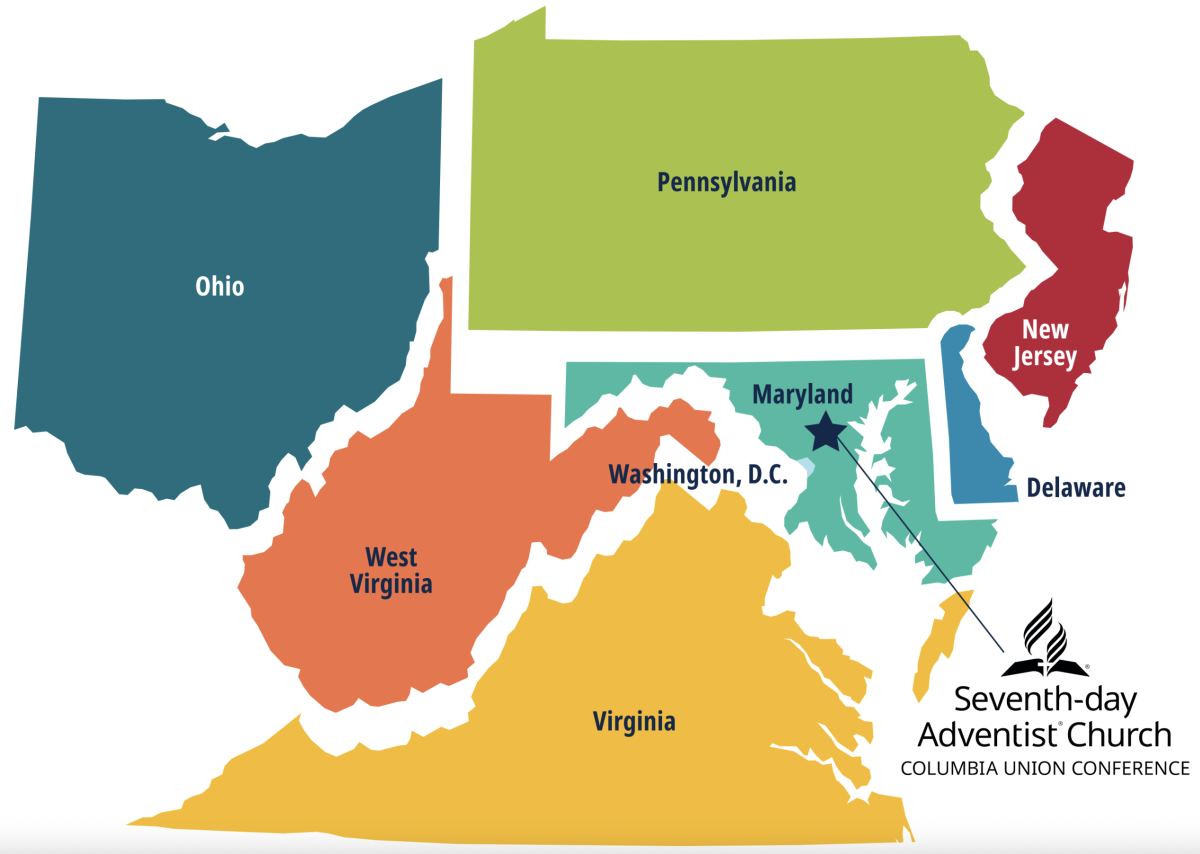
Why Was the Columbia Union Created?
In the early 1900s, leaders at the General Conference—the world headquarters of the Seventh-day Adventist Church—recognized that the church’s rapid membership growth made it increasingly difficult to manage issues at the conference and local church levels. Their solution was to create and incorporate union conferences—commonly referred to as “unions”—into the church’s organizational structure.
After establishing several union conferences in North America, church leaders recognized the need for a new union conference in the Mid-Atlantic area. Leaders from the already established Atlantic Union Conference agreed to release the states of Delaware, Maryland, New Jersey, Pennsylvania, Virginia and West Virginia, and leaders from the Lake Union Conference consented to release Ohio.
On November 17, 1907, church leaders held an organizing session in Philadelphia to officially form the Columbia Union Conference. The Columbia Union was then further organized into conferences by state, and Washington, D.C., was later added.
On that day, leaders voted to prioritize reaching “the people of the great cities of this Maryland field.” They noted a “call for the consecration of every resource to service” and the objective to “press our work into unentered portions” of the field. They also pledged to engage in mission work among the major immigrant groups in cities at that time.
Additionally, the union was to provide training for outreach and nurture, encourage the church’s youth to attend its schools for training to be missionaries (at home or abroad) and support “better patronage” for “our sanitariums” (hospitals) through greater marketing efforts.
Official operations for the Columbia Union began a few weeks later. Membership totaled 5,320 across 187 churches, with paid employees comprising 43 ordained ministers, 23 licensed ministers and 59 licensed missionaries.
In 1924, the Potomac Conference was formed by merging the Virginia and District of Columbia conferences. Two decades later, in 1944, the Allegheny Conference was established to serve Black Americans and all people groups, regardless of race, culture or national origin. This conference was later divided in 1966 into the Allegheny East and Allegheny West conferences, which were officially organized January 1, 1967. Another merger occurred in 1963, when the East and West Pennsylvania conferences united to form the Pennsylvania Conference. In 1971, the West Virginia Conference was reorganized, becoming the Mountain View Conference, with a heart for reaching the people of Appalachia.
A Central Hub For Conferences
The Adventist Church uses a representative form of governance, says Robinson, who explains that members are the ones who choose who sits on their local church boards. This level of representation is repeated at the union and conference levels.
At the union and conference level, this board is called the executive committee. This governing body of the Columbia Union typically meets four times a year to hear reports from departmental and entity leadership. These 46 committee members—chosen to reflect diversity of race, location, gender and age—are nominated by the entities they represent and provide oversight on the union’s operations.
They also approve the ordination of pastoral candidates submitted by local conferences, approve special project funding, union personnel changes and work together with conference leadership to cast a vision for the territory.
Robinson notes that the Columbia Union executive leadership team and executive committee provide oversight for the conferences, ministries and institutions within the union’s territory. “We sit on all the boards and committees to help the conferences—not to run the conferences—focus on the mission of the church, and work in harmony with the Seventh-day Adventist Church’s governance.”
David Richmond, a representative from the Pennsylvania Conference, has served on Columbia Union’s executive committee for nine years. When he joined, he says he “learned that the union doesn’t tell the conferences what to do.”
Conference presidents inform union leadership of the ways the union can help them. Richmond adds, “So, it’s a bottom-up rather than a top-down structure. In a way, we are looking to see how we can come alongside the people who are doing ministry and empower them so that they have the resources that they need to do the work they need to do.”

Every five years, the executive committee joins a broader group of constituent delegates at a constituency session where they elect Columbia Union’s leadership team. At this meeting, delegates have the authority to change bylaws, elect the executive committee, and create or dissolve ministries and organizations within their fields.
The Columbia Union also works to support the conferences in adhering to and implementing organizational policy and respective constitutions and bylaws.
One of the responsibilities of the union’s executive secretary—one of the three officers who make up a union’s executive leadership team—is to work with the conference-level executive secretaries to coordinate and facilitate their constituency meetings, which are held every five years. “It is a progressive process that generally takes about a year, and includes meetings of the bylaws committee, organizing committee, nominating committee and finally the constituency meeting of the delegates from their churches,” says Celeste Ryan Blyden, Columbia Union executive secretary.
Another way the union executive secretary helps to support and strengthen denominational work is by maintaining employee service records, processing requests for ministerial credentials and interdivision travel, recording meeting actions and minutes, and gathering and sharing union-and church-related demographics and statistics.
Through an annual Secretariat/HR training, employees from the union entities and conferences gather to learn about timely and relevant topics and issues that impact the church’s work. Over the years, the group of about 50 has discussed leadership strengths, human resources, employment law, immigration and how to navigate crisis situations that impact the church.
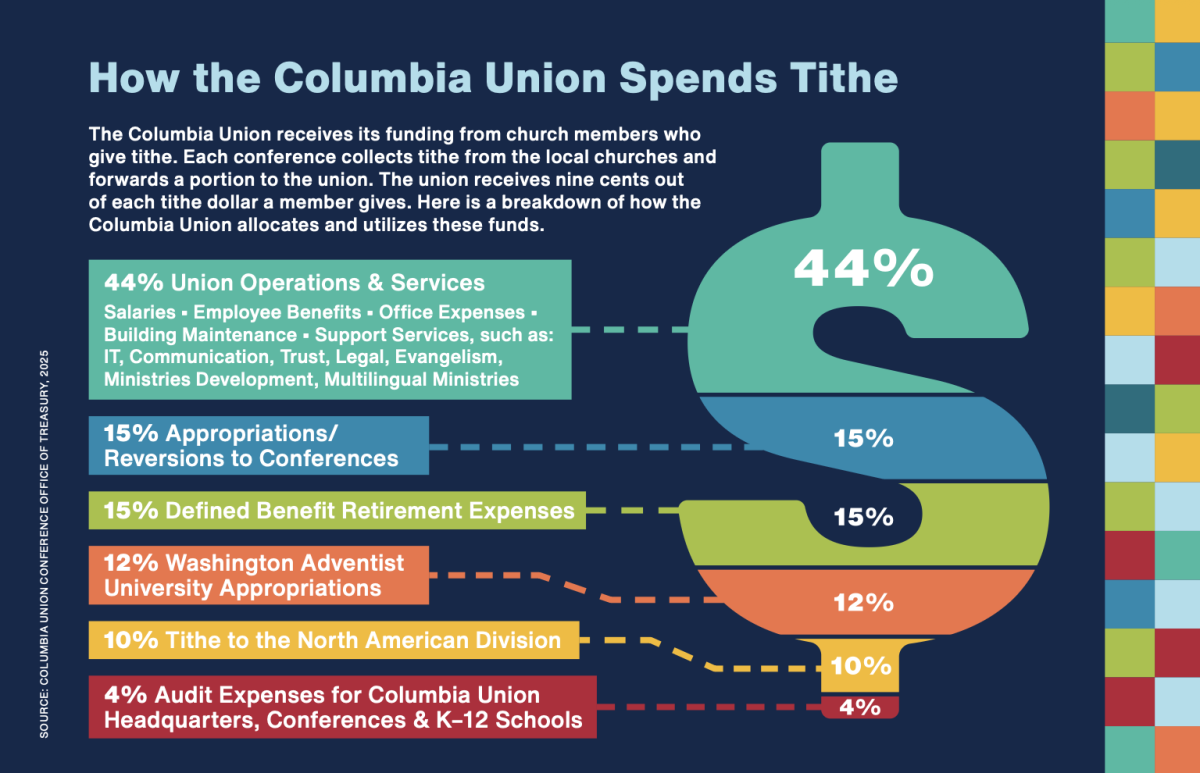
No Mission Without Margin
The Columbia Union receives its funding from church members who give tithe to their local church.
The conference collects the tithe from the local churches, then forwards a portion to the union. The union receives nine cents out of each tithe dollar a member gives. The union’s Treasury Department supports the financial stability of its organizations, which
includes subsidizing auditing expenses of all eight conferences and K–12 educational institutions—a yearly expense of more than 700 thousand dollars.
Each year, the union also reverts about 15 percent of its budget back to the conferences to strengthen the mission.
“We must efficiently and effectively use our resources in a way that will honor God. And, in the process, we will be able to do the mission that has been assigned to us,” says Emmanuel Asiedu, Columbia Union treasurer.
In addition to funding ministries, Treasury facilitates a mentorship program that prepares treasury and accounting professionals to lead and serve in the church. Asiedu notes that, as a result of the mentorship program, there are at least 12 people who now work as treasurers or financial leaders throughout the Columbia Union and North American Division (NAD).
“Without qualified, competent, moral financial leaders, the mission would be stopped, because you need those people to be able to strategically manage and allocate the financial resources to areas that are important to the church,” Asiedu adds.
He also notes that without the union, there would be financial instability in some of the smaller conferences. “The union is positioned to allocate resources to ensure that the conferences that are struggling because of size or that have fewer financial resources are able to get additional resources they need to further the mission.”
Columbia Union leadership believes that the mission is not restricted to its territory. Asiedu says that, with the assistance of the union’s two health care systems, it is able to help with projects around the world—assisting individuals with education and health care by supporting Adventist schools and building clinics in places such as India, Vietnam, Cambodia, Tanzania, Uganda, Ghana, Liberia and other countries.
The Columbia Union Revolving Fund (CURF), a nonprofit organization affiliated with the Columbia Union, provides local churches, schools and other denominational ministries with affordable financing to support growth through construction, property acquisition, renovations and more.
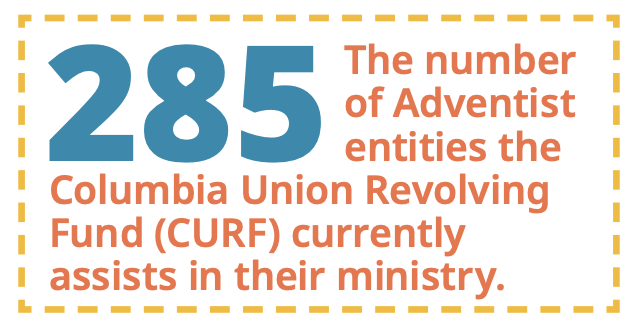 Empowering Evangelism
Empowering Evangelism
Elaine Buchanan, a lay member who represents the Mountain View Conference on the Columbia Union Conference Executive Committee, says she can tangibly see the resources and tools the union gives in evangelism support.
The Office of Evangelism provides this support and training to members and the eight conference Evangelism departments, as well as to special evangelism efforts across the territory—overseeing an estimated 2,025 weeks of evangelism crusades in 2025 alone.
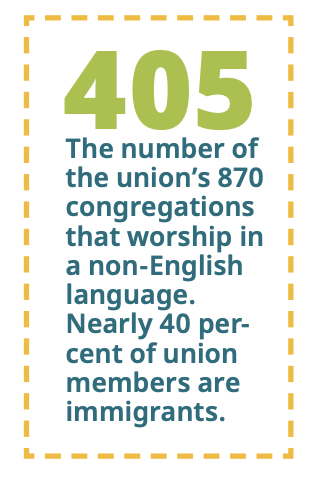
The Office of Multilingual Ministries also provides resources and support to the conferences and pastors to help them meet the varying outreach needs of the union’s 17-plus language groups—a rapidly growing demographic.
The Office of Ministries Development works closely with conferences to support the Adventist Community Services and Disaster Response departments, Children’s and Youth Ministries, and Pathfinders.
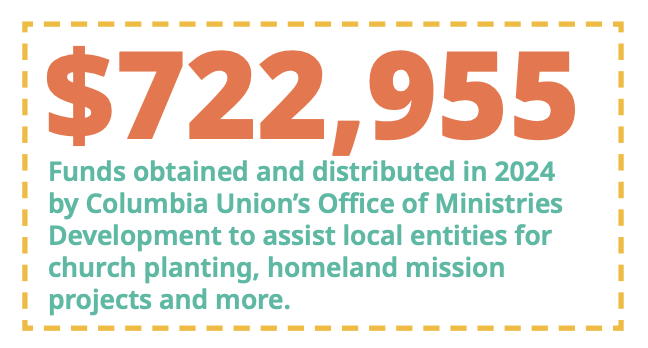 Each year, the department also serves as an intermediary between the NAD and conferences to secure funding for innovative ministry projects at local churches. In 2024, they helped local churches obtain funds used toward 51 church plants, 32 “homeland missions” projects, five church revitalization projects, $15,000 toward community service projects and one urban center of influence—totaling $722,955 in funds distributed throughout the year.
Each year, the department also serves as an intermediary between the NAD and conferences to secure funding for innovative ministry projects at local churches. In 2024, they helped local churches obtain funds used toward 51 church plants, 32 “homeland missions” projects, five church revitalization projects, $15,000 toward community service projects and one urban center of influence—totaling $722,955 in funds distributed throughout the year.
Each year, the Office of Education supports educators and administrators throughout its early childhood education centers, 53 elementary schools, six junior academies and nine senior academies. The union also charters Kettering College, a school on the campus of Kettering Health in Dayton, Ohio, that equips students to minister in the medical field, and Washington Adventist University, which offers degrees in professional and liberal arts undergraduate and graduate programs from its Takoma Park, Md., campus.
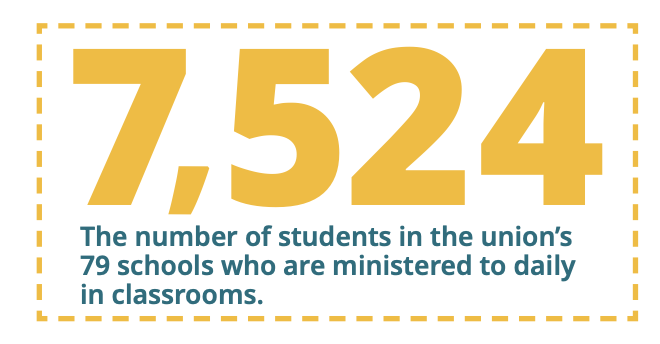
Union education staff also assist in the formulation of system-wide policies, mission-driven strategic program development, school accreditation and teacher certification.
Among other professional development programs, last summer, the Office of Education hosted some 75 educators at the Principals’ Bootcamp, a training that focused on preparing “leaders to lead.”
Unique to the Columbia Union is its sponsorship of two separate health care networks. Adventist HealthCare, based in Maryland, runs five hospitals and has 2,180 physicians and medical staff across their network. Kettering Health in Ohio operates 14 medical centers and more than 120 outpatient facilities.
Keeping Members Informed and Connected
Cheryl Chavers, a representative from the Allegheny East Conference, says she likes serving on the executive committee because she gets “to see what everyone else [around the union] is doing, and then I can relay that back, especially as a lay person … to the members in my local area. It’s also very empowering and encouraging to see that so many people are just inspired, that they’re motivated, that they’re on fire for the Lord, and to see the very unique things that are being done across the union.”
She also notes that without the union, “it would be very difficult for information to trickle on down from the division level to, let’s just say, the local church.”
In print, online, through social media, in a weekly e-newsletter and on the Columbia Union app, the Office of Communication keeps members across the union’s territory informed through its dedicated news source—the Visitor. Six times a year, every Columbia Union household receives a free copy of the Visitor magazine, which delivers localized news, inspiration and resources. Members also receive the annual Columbia Union calendar, which provides important union-wide dates. In addition to real-time news coverage, the Office of Communication offers corporate identity resources and branding guidance, manages external media relations and public outreach, and provides crisis communication support.
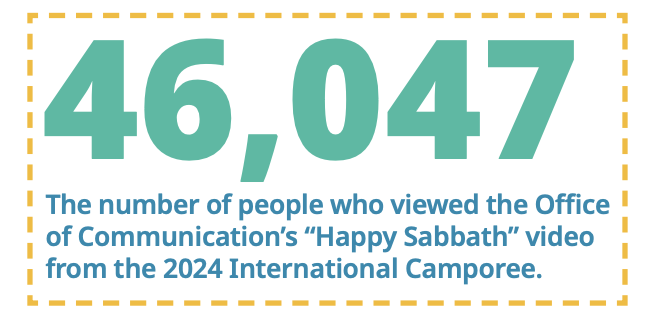
Another ministry closely affiliated with the union is WGTS 91.9, which shares hope-filled music with half a million listeners who tune in each week via the radio, online and through numerous outreach events.
Thanks to the support of Columbia Union’s Information Technology Services (ITS) team, the union office and 600 employees across six of the eight conferences are able to stay connected and work efficiently. ITS manages more than 200 workstations; oversees nearly 20 terabytes of data storage; administers robust identity and device security, monitors compliance and efficiency; and works to keep offices ahead of potential problems.
The department proactively works to educate and empower local conferences and schools about growing IT needs. “It’s something that has to be continually addressed, or we end up in a crisis,” says Greg Iverson, ITS director.
The department has been working to assist union and entity employees to understand AI and encourage them to adopt AI usage guidelines. The team has also been proactive in educating staff on phishing resistant authentication to prevent malware attacks.
The Office of General Counsel provides legal guidance to the various ministries within the Columbia Union and lends advice to union and conference officers in their day-to-day administrative functions. In addition, this department helps to protect the church’s physical assets and intellectual property. It advocates for religious freedom, extends support to members who face religious discrimination in the workplace and assists in the preparation of estate planning.
From its early beginnings, and continuing today, staff at the Columbia Union Conference are committed to seeking ways to partner with conferences, schools and organizations to engage members of all ages in mission, ministry and evangelism—all to fulfill the most important goal: “To help everyone become connected with Christ,” says Robinson, who prays for members to fall in love with Jesus as their personal Lord and Savior.
 Read and share our May-June 2025 Visitor Articles:
Read and share our May-June 2025 Visitor Articles:

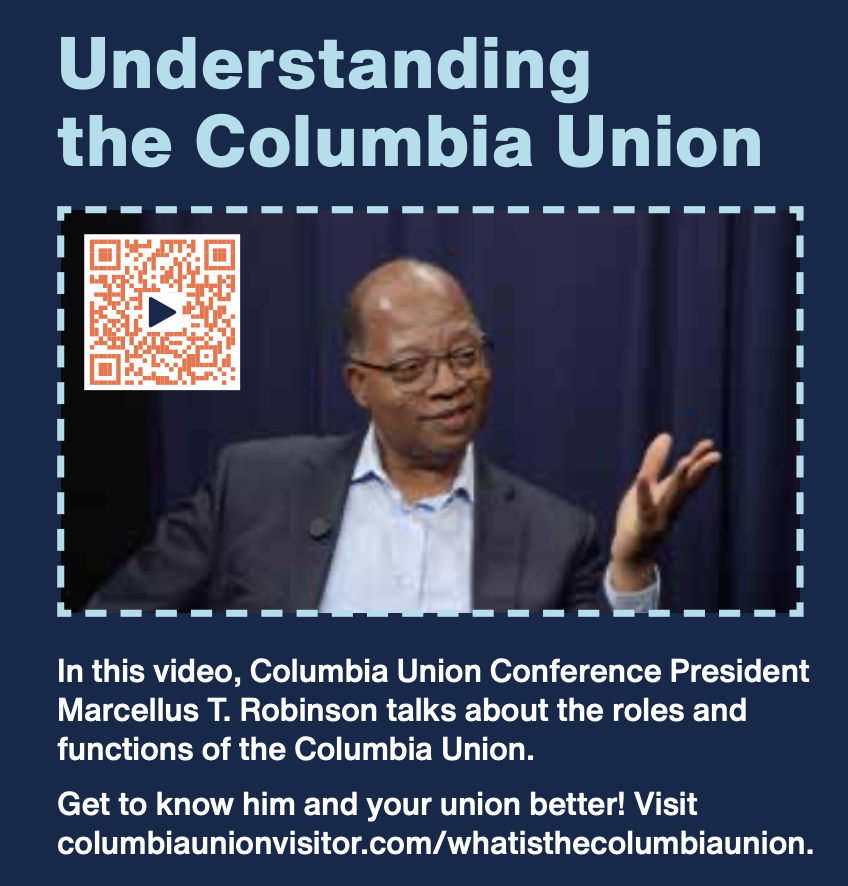
Add new comment